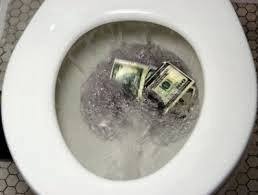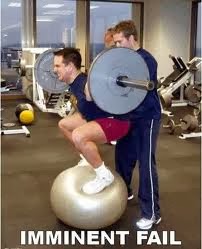http://www.sodahead.com/united-states/do-you-think-the-american-dream-is-dead/question-1238197/?link=ibaf&q=pissing+money
What vitamins and supplements do you take? Do you know what your recommended daily intake (RDI) is in relation to how much you are actually taking? Do you even know why you are taking them? Like most people, you probably don't know the answer to all those questions. But one thing is for sure, if you are like 54% of North Americans you are taking something[1]. Problem is, the only benefits you might be receiving is the yellow glow of expensive urine. Also, if you exceed your Tolerable Upper Intake Level (TUIL) on many vitamins and minerals, they can turn toxic in your system and have some seriously adverse affects (too much of a good thing can kill you)[2].
Some of the most commonly taken supplements and vitamins: Protein powder, Creatine, Amino acids; Vitamins, A, B12, C, D, E, Calcium & Magnesium, Iron, Glucosamine Chondroitin, and Omega 3.
First though, let's take a look at the most common pill taken of all...the Multivitamin.
Multivitamin
The multivitamin is a once per day pill (depending on the brand you take) that was designed to give you a dose of all of your major micronutrients. These micronutrients can be consumed in regular food, but given the low quality of mass produced food and the poor state of the average diet in North America, a quality multivitamin can add balance.
Recommended Daily Intake (RDI) is usually measured in mg (milligrams) or IU (International Units)
Here is a quick look at Centrum - for Men, a once per day multivitamin that is a recognized brand:
(Dose per pill) (Recommended Daily Intake)*[3] (TUIL)[4]
Vitamin A ...................... 1000 IU .............................. 5000 IU ................... 8700 IU
Vitamin E ...................... 1500 IU .............................. 30 IU ........................ 2000 mg
Vitamin C ...................... 180 mg ............................... 60 mg ....................... 2000 mg
Vitamin B12 .................. .0216 mg ........................... .006 mg ..................... N/A
Vitamin D ....................... 800 IU ............................... 400 IU ...................... 4000 IU
Calcium .......................... 300 mg .............................. 1000 mg ................... 2500 mg
Magnesium ..................... 84 mg ................................ 400 mg ..................... 400 mg
Iron .................................... 6 mg .................................. 18 mg ....................... 45 mg
*Ranges by age (older = more) and sex (male = more), but I will take average
-This pill provides other vitamins and minerals, but I will stick to the discussed ones
As you can see for yourself, the multivitamin vastly over-doses the consumer on some of the vitamins and minerals (Vitamin E & D), but under-represents others (Vitamin A & Calcium). Before you scream in outrage though, you should know that one carrot gives you 7835 IU and that 50g of swiss cheese gives you 500mg. Oh yeah, also, you should be aware that vitamins are a supplement, not a meal.
Pee Value: $ - It is always best to get your RDI from real foods, but multivitamins are reasonably cheap and a good insurance policy if you have a marginal diet.
Protein Supplements (Powders, Bars, Drinks)
There is little debate surrounding weather or not adding a protein supplement to your diet can help repair muscles faster, make you feel fuller, and is convenient. What makes your pee expensive, is how much more protein you are consuming at one time than is actually biologically available (usable) to your body. People who work out for an hour per day, 5 days per week can use around 0.5g or protein per pound of body weight. While elite level athletes function best at around 0.75g of protein per pound[5]. Additionally, our bodies can only absorb between 30g and 40g of protein per 2 hours, so if you are making a 100g protein super shake, the cost of your pee, per volume, will rival that of current gas prices.
Pee Value: $$$ - Knowing how much protein to consume as a supplement is crucial; know your limit and stay within it. If you consume in excess, not only will you be peeing out gold, but your kidneys could pack up their beans leave town, leaving you with damaged filters.
Creatine Monohydrate - (can be taken while working out, but also effective recovery)
Creatine has been proven to increase an athletes training capacity when taken in proper dosage (3-5g per day)[6]. It is recognized as somewhat of a wonder drug in athletics as it appears to be safe (though long term effects are mostly undocumented as it is relatively new), and there is research that when coupled with increased carbohydrates and protein it aides in muscle retention.
Pee Value: $$ - While there are foods that contain creatine (salmon, pork, beef, etc), by the time you cook and prepare the food, the creatine quality is vastly diminished. If you are training for a sport, I would definitely recommend taking creatine in proper dosage, but if you are just lifting to add muscle, I question if it is really worth it? Good quality creatine is usually pretty pricey, so it'll cost you if you decide it is.
Amino Acids (BCAAs & SAAs) - (generally taken during workouts)
Branch Chain Amino Acids and Silk Amino Acids are another recovery agent that claim to aid in in training and diminishing the effects of muscle fatigue during your workouts by oxygenating the blood. Science says, yes, it works[7]. I agree with science. Similarly to Creatine, if you are an elite athlete, I recommend BCAAs and SAAs. If you aren't, I don't understand the point.
Pee Value: $$ - You will find BCAAs and SAAs as expensive, if not more-so, than Creatine. If you stay within the 'intense training guidelines' of 7g per day, you will see benefits in your intensity. If you lack intensity and focus in the first place, well, it ain't magic in a can.
Vitamins A, B12, C, D, E
A - Eye sight, skin & immune support, cell growth
B12 - Help produce energy, support formation of red blood cells
C - Antioxidant (eliminates free radicals), growth & repair of body tissues, helps make collagen
D - Helps make strong bones (when combined with Calcium), may help protect against cancers
E - Antioxidants help boost immune system, contributes to formation of red blood cells
Pee Value: $ - Vitamins A through E can help offer support in a nutritionally diminished diet. But you will notice some overlap in what the vitamins provide, and keep in mind that many of these vitamins can be consumed in real food. Vitamins like A and E are in everything (except fast food...thats not real food), so before you take a multivitamin AND all these others, take a moment to see if you really need them. Assessing your need could save you $30 per month or more.
Calcium & Magnesium
Magnesium...WTF?!? Who has ever heard of a magnesium deficiency? Well, likely you haven't. But Calcium, like many other minerals, needs to be consumed in a certain ratio with other minerals to be properly absorbed, otherwise, you guessed it...it ends up in your toilet boil. Vitamin D also commands a necessary presence to enhance Calciums absorption in to bones. Lucky for you, these three often come properly dosed in one pill. Calcium and magnesium are critical in muscle contraction and relaxation, as well as muscle repair and transmission of nerve impulses[8]. They can be found in meats and vegetables of all sorts.
Pee Value: - I would recommend a Calcium-magnesium-vitamin D pill to everyone. It is inexpensive and has all kinds of benefits. Many people lack vitamin D and Calcium in their diets and magnesium is instrumental to absorption of vitamins C, E & D as well as calcium, sodium and potassium. It is naturally found in rice, hazelnuts and beans.
Iron
Can help increase energy in those with low blood pressure. Women are especially in danger of lacking enough iron in their diets, which is essential to bone health (among other things). Supplementing iron has also been shown to improve concentration and attention (presumably by reducing feelings of fatigue)[9] regardless of the individuals baseline levels.
Pee Value: $ - Iron can be purchased inexpensively and has been shown to have many benefits. It is fairly low risk; even a small dose can have positive effects. It is found in spinach, oatmeal, yogurt and beef.
Glucosamine Chondroitin
GC has scientific basis in helping to slow osteoarthritis in patients who already suffer from it and easing its symptoms. It claims to have properties that support joint health (knees, elbows, etc). Beyond helping those who suffer from the illness, it has no application. There has been no evidence found that it supports joint health in healthy individuals.
Pee Value: $$ - Don't get caught in this trap. Do your research (guess you just did by reading this). It is fairly pricey, and unless you suffer from osteoarthritis, it won't do a damn thing for you. Shame on you pill industry.
Omega 3
The omegas (3, 6 & 9) have received a big push in to popular nutrition. They have garnered the reputation of decreasing cholesterol and contributing to good heart health. The are considered the "good fats" in most circles and are found in nutrient rich foods. Because Omega 3 is a fatty acid, there technically is no Recommended Daily Intake (RDI), but the American Hearth Association recommends between 1 and 4 grams of Omegas per day (3 oz. of salmon -roughly 1 serving- gives you about .9g of Omega 3).
Pee Value: $$ - Omegas are great. And I support taking a supplemental pill each day, whether you have heart issues or not. Omegas are a little more expensive than your average vitamin, but are worth the price if your diet lacks them normally. A word of caution, many baked goods claim to have Omegas because they include Flax seeds. Yes, Flax has omegas, but as soon as they are exposed to the baking process, they become denatured and offer little more value than fibre. Foods that contain omegas: fish eggs, rice and beans.
Recommendations
Whenever possible, try to get you vitamins, minerals, and nutrients from real food. A good way to know if you are getting them is to write down an average day of eating and then calculate what you are getting (don't be lazy, it'll take no more than 15 minutes). If you are above or around your RDI's then you likely don't need supplements. If you are lacking, then consider what you do need, and don't take more; more is not always better. Also, if you are working out and are contemplating taking protein, creatine, and amino acids, take a moment to think about WHY you are training, what your goals are and if it is really necessary to spend the money on further supplementation. If you exercise regularly and may lack all of the nutrients you need from incomplete meals or time constraints, here is what I recommend:
each day take...
1 Protein shake
1 Multivitamine
1 Calcium-magnesium-vitamin D
1 Iron
1 Omega-3
Cost to you as insurance on your health per day - $1.57/day
Chance of exceeding your Tolerable Upper Intake Levels - 0%
Value of your pee - You can stomach it ;)
Sources Cited
1 http://www.nielsen.com/us/en/newswire/2009/north-america-asia-lead-vitamin-and-supplement-usage.html
2 http://www.organicconsumers.org/articles/article_18619.cfm
3 http://www.unc.edu/~rowlett/units/scales/dailyvalues.htm
4http://iom.edu/Activities/Nutrition/SummaryDRIs/~/media/Files/Activity%20Files/Nutrition/DRIs/ULs%20for%20Vitamins%20and%20Elements.pdf
5 http://www.menshealth.com/mhlists/guide-to-protein/printer.php
6 http://www.jissn.com/content/4/1/6
7 http://jn.nutrition.org/content/136/2/538S.full
8 http://www.enerex.ca/en/articles/calcium-to-magnesium-ratio
9 http://www.nutritionj.com/content/9/1/4



















